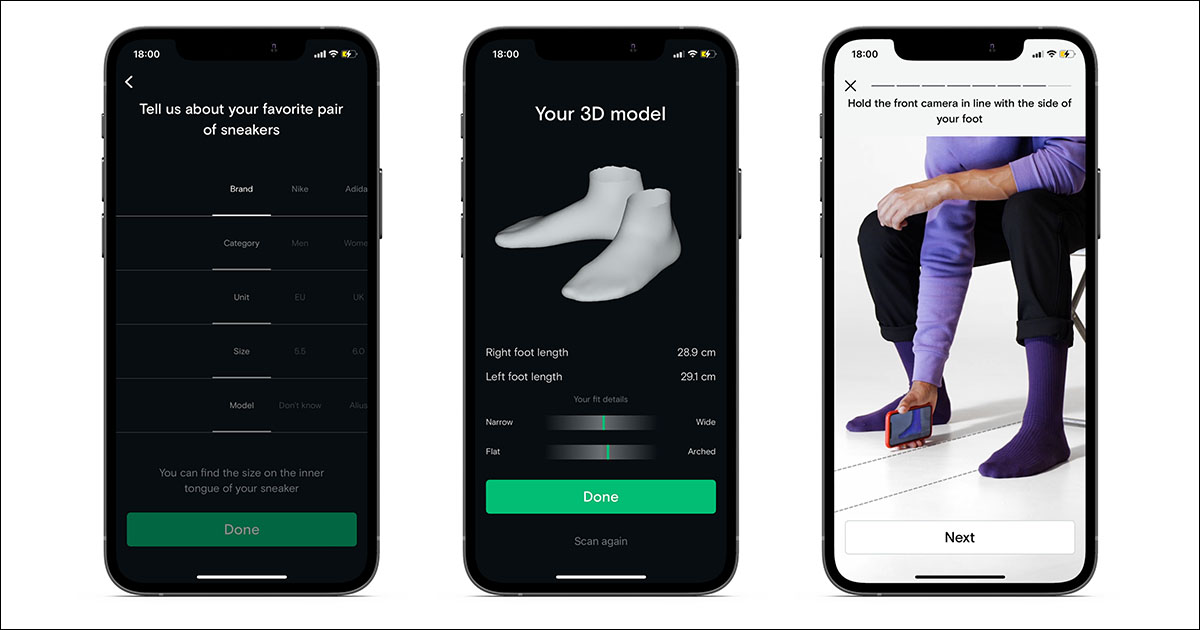Your iPhone Is Now an AI-Powered Foot Scanner With Neatsy
The Origin Story of AI Startup Neatsy

Last Updated: By TRUiC Team
Everyone knows how hard it can be to find shoes that really fit. Trying them on in the store for a minute or two often isn’t enough, and sizing can vary from manufacturer to manufacturer. Plus, once you get them home and break them in, the fit might not have been ideal.
Artem Semjanow, the founder of Neatsy, has a solution. Previously the CEO and chief of research and development at Prisma Labs, he created an app that scans and analyzes users' feet to identify their true shoe size. This is Neatsy’s origin story.
Online Shopping Challenges
Semjanow saw the need for something like Neatsy when dealing with his own shoe-sizing problems. Due to the shape of his feet, it has always been a challenge for him and his brother to find proper footwear, and ill-fitting shoes have caused them knee pain and led to other health problems.
So, they set about trying to solve this problem using their engineering background, especially their knowledge of computer vision. They hit upon the idea of using a cell phone as a measuring device to scan your entire foot. “We just started to ask our friends, did they have the same kind of problem? We also figured out that a lot of people hesitate to buy things before they try them on – it's kind of a barrier for them.” In fact, many people refuse to buy shoes online altogether to avoid the hassle of returns.
Eventually, they met someone who worked in the ecommerce department at Adidas. He said his company had a “huge problem” with people returning shoes they purchase online because of fit issues. He also said Adidas wanted to improve the overall customer experience so people would be more comfortable with buying other types of clothing online. “So I figured out, hey, this is a customer problem and also a big-company problem that we can try to work on some solutions for,” Semjanow says. “And that's how Neatsy started.”
Development of Neatsy
The company’s app relies on augmented reality and took about a year and a half to perfect. The app piggybacks on Apple’s Face ID camera technology (which means it only works on Face ID-enabled Apple devices), in part because the technology is good at sensing depth. Neatsy’s patented artificial intelligence-based algorithm works with and enhances Face ID to improve three-dimensional imaging even further with computational techniques similar to those used by self-driving cars.
In practice, the app takes four pictures to construct a complete 3D model of someone’s foot and crunches some numbers. Then it produces key data like length, width, and arch height, as well as information about possible health issues like overpronation or flat feet. The app also provides specific shoe recommendations using the customer’s data combined with online reviews. For example, if several people with narrow feet say a shoe isn’t comfortable for them, and the app user has a narrow foot based on the measurements taken, the app accounts for this in suggesting which shoes to purchase.
Neatsy’s original business idea was for people to download the app and use it to measure their feet so they could buy properly fitting shoes by opening the app of a given shoe store from within the Neatsy app. However, this approach was difficult to monetize for several reasons. For example, if someone switched to a web browser to complete a shoe purchase, Neatsy wouldn’t receive any affiliate revenue for that sale. In addition, Apple’s and Google’s privacy measures made it very difficult to track everyone’s transactions. “Overall, our business model just didn't actually work,” Semjanow says.
So the company has switched to a B2B model in which Neatsy sells access to its platform directly to shoe companies, with the promise (backed by data) that those companies will more than recoup the cost through higher shoe sales. Neatsy has completed several pilots confirming that its app boosts conversion rates by about 30%-50%. This business model has been much more successful, with eleven partner companies – including top brands like Nike, Adidas, and Under Armour – on board so far. ”It’s a pretty easy-to-understand deal for them, and that's what we are trying to scale today,” he says.
However, persuading investors wasn’t so easy – at least at first. “Even if you do really interesting things from a technical point of view, it’s so hard to convince [investors] that it's really good, it's really working, when you don't have lots of clients and a working proven business model,” he says. “It's a super-intense job that has to be done [well], and you have to build a team that helps you.”
What’s Next for the Startup
Over the long term, Semjanow sees the company expanding into the broader health and fitness space. “We're trying to help people buy shoes online for every kind of activity,” whether that’s trail or asphalt running, basketball, rock climbing, or some other sport, he says. Whatever your passion, his vision is that Neatsy would provide suggestions about which shoes would fit you best.
In addition, the company is trying to build on its scanning software to develop a way to model the entire body in three dimensions for the purpose of identifying potential health risks. While it obviously can’t provide medical diagnoses, it could suggest that someone go to a particular medical specialist for a consultation. The software could potentially detect foot problems like flat feet and overpronation, for example. Using a full-body scan, it also could track things like muscle development from working out. “[We’re] excited that we can make people healthier,” he says.
Next Steps:
- Check out Neatsy’s company profile, their insights for aspiring entrepreneurs, and ways to support them!
- Keep up with more startup companies by visiting our list of the top startups to watch.
- Hear startup stories from real founders on the Startup Savants podcast.
- Form your own startup by reading our review of the best online incorporation services.
Tell Us Your Startup Story
Are you a startup founder and want to share your entrepreneurial journey with our readers? Click below to contact us today!


